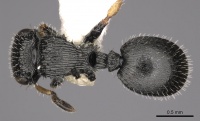Cataulacus taylori
| Cataulacus taylori | |
|---|---|

| |
| Scientific classification | |
| Kingdom: | Animalia |
| Phylum: | Arthropoda |
| Class: | Insecta |
| Order: | Hymenoptera |
| Family: | Formicidae |
| Subfamily: | Myrmicinae |
| Tribe: | Crematogastrini |
| Genus: | Cataulacus |
| Species: | C. taylori |
| Binomial name | |
| Cataulacus taylori Bolton, 1982 | |
Nothing is known about the biology of Cataulacus taylori.
Identification
A member of the tenuis group.
Keys including this Species
Distribution
Distribution based on Regional Taxon Lists
Afrotropical Region: Nigeria (type locality).
Distribution based on AntMaps
Distribution based on AntWeb specimens
Check data from AntWeb
Countries Occupied
| Number of countries occupied by this species based on AntWiki Regional Taxon Lists. In general, fewer countries occupied indicates a narrower range, while more countries indicates a more widespread species. |

|
Estimated Abundance
| Relative abundance based on number of AntMaps records per species (this species within the purple bar). Fewer records (to the left) indicates a less abundant/encountered species while more records (to the right) indicates more abundant/encountered species. |

|
Biology
|
Castes
Nomenclature
The following information is derived from Barry Bolton's Online Catalogue of the Ants of the World.
- taylori. Cataulacus taylori Bolton, 1982: 364 (w.) NIGERIA.
- Type-material: holotype worker, 1 paratype worker.
- Type-locality: holotype Nigeria: Gambari, CRIN, 24.v.1976, black pod project (B. Taylor); paratype: Nigeria: Onipe, CRIN, 25.vii.1975, black pod project (B. Taylor).
- Type-depository: BMNH.
- Status as species: Bolton, 1995b: 139.
- Distribution: Nigeria.
Unless otherwise noted the text for the remainder of this section is reported from the publication that includes the original description.
Description
Worker
Holotype. TL 3.2, HL 0.82, HW 0.76, CI 93, EL 0.42, OI 55, SL 0.44, SI 58, PW 0.60, AL 0.90.
With the head in full-face view the sides behind the eyes denticulate, ending in a tooth at the occipital corner. Occipital crest absent, the dorsum rounding evenly into the occiput; the occipital margin unarmed except for a smaller tooth close to the one at the corner. Eyes relatively large, OI > 50. With the alitrunk in profile the highest point of the dorsum at about the midlength of the pronotum. In front of this the dorsum slopes down to the cervical shield and a few scattered minute peaks occur on the outline. Behind the highest point the dorsum is shallowly convex and slopes evenly downwards towards the bases of the propodeal spines. Mesokatepisternal tooth developed. Metapleural lobes low and rounded. Propodeal spines in profile narrow, slightly downcurved along their length. Alitrunk in dorsal view with the pronotal corners denticulate, the lateral margins of the pronotum with 6-7 projecting triangular denticles. Sides of mesonotum and propodeum each with a single projecting denticle, the latter also with the sides convex at the site of the spiracle. Propodeal spines narrow and evenly divergent in dorsal view. Petiole in profile rising to a sharp peak above. Subpetiolar process complex, with a narrow rounded projecting blunt anteroventral angle and a spur-like posteroventral angle, the ventral surface between the two angles strongly concave. Postpetiole node with dorsal surface denticulate, the ventral process narrow and digitiform. Dorsum of head feebly reticulate-rugulose, the rugulae very weak, fine, low and rounded, the reticular meshes mostly incomplete and irregular in shape and size. Ground-sculpture in the meshes almost completely effaced, the surface glossy. Dorsal alitrunk predominantly longitudinally rugose, with some anastomoses on the pronotum but behind this the rugae straight and parallel, quite broad and without cross-meshes. Spaces between the rugae glossy and almost smooth, with only the faintest vestiges of ground-sculpture. Rugae on declivity between bases of spines transverse. Petiole and postpetiole longitudinally rugose, the rugae converging posteriorly. First gastral tergite shiny, with superficial fine reticulate-puntulate sculpture everywhere and with a weak pattern of very fine longitudinal irregular rugulae. Stronger longitudinal rugulae present on the basal one-fifth of the tergite. First gastral sternite similarly but even more delicately sculptured. Dorsum of head with numerous short stout straight cylindrical hairs which are blunt apically. All remaining dorsal surfaces of body with similar pilosity, the longest hairs occurring on the base of the first gastral tergite where they are slightly recurved. Colour uniform glossy jet black; the scapes, tibiae and tarsi dull yellow.
Paratype. TL 3.5, HL 0.88, HW 0.81, CI 92, EL 0.45, OI 56, SL 0.46, SI 57, PW 0.67, AL 0.96.
As holotype but slightly larger, its subpostpetiolar process shorter and broader than in the holotype. The rugae on the dorsal alitrunk not running straight back as in the holotype but slightly skewed to the left posteriorly.
Type Material
Holotype worker, Nigeria: Gambari, CRIN, 24.v.1976, black pod project (B. Taylor) (The Natural History Museum). Paratype. Nigeria: 1 worker, Onipe, CRIN, 25.vii.1975, black pod project (B. Taylor) (BMNH).
References
- [[Media:Bolton 1982.pdf|Bolton, B. 1982. Afrotropical species of the myrmecine ant genera Cardiocondyla, Leptothorax, Melissotarsus, Messor and Cataulacus (Formicidae). Bulletin of the British Museum (Natural History). Entomology, 46: 3*Mbenoun Masse, P.S., Ebolo, G.L.M., Titti, G.E., Mony, R. (2021) Ant species richness, abundance and functional groups along an elevation gradient in Central Cameroon Biodiversity Journal, 2021, 12 1.: 179–194. Biodiversity Journal 12, 179–194 (doi:10.31396/biodiv.jour.2021.12.1.179.194).
07-370.]]

